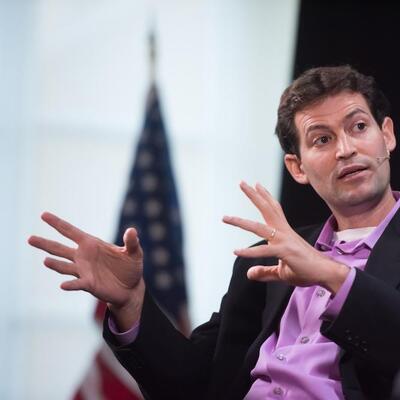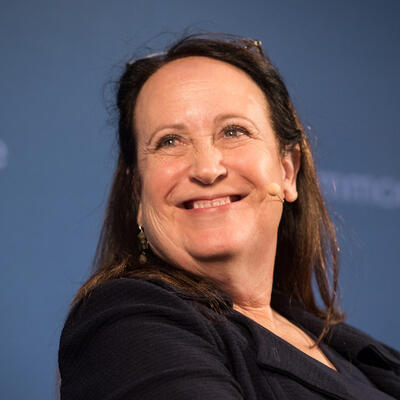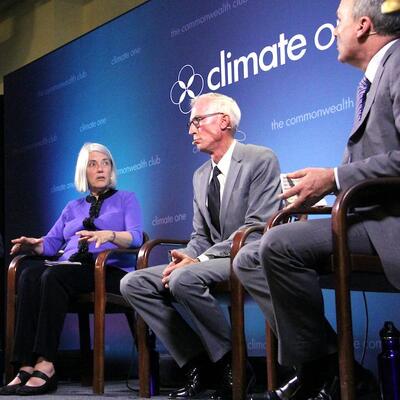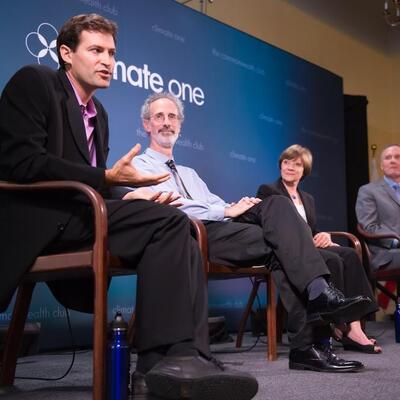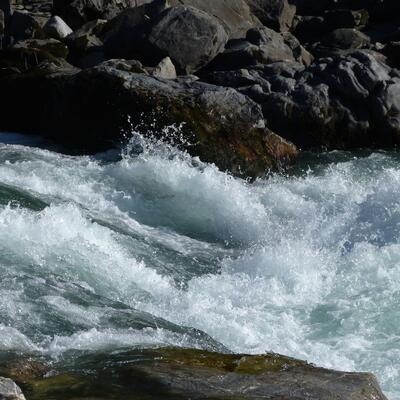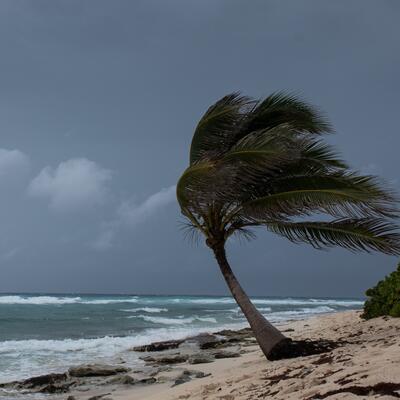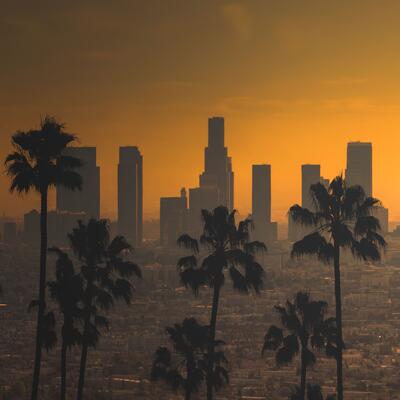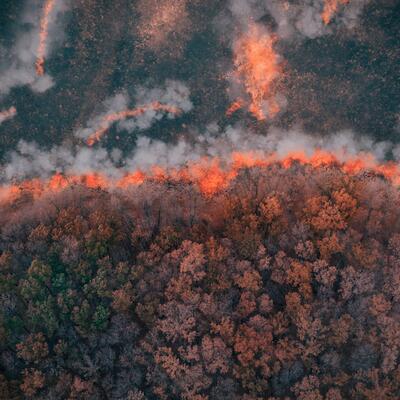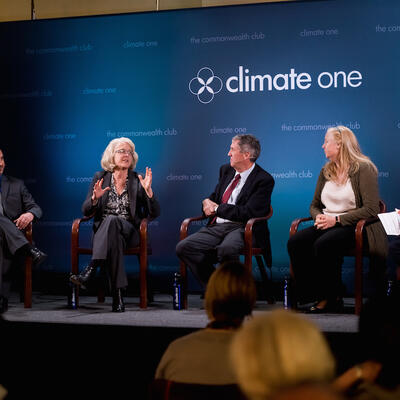
After El Niño Now What?
Guests
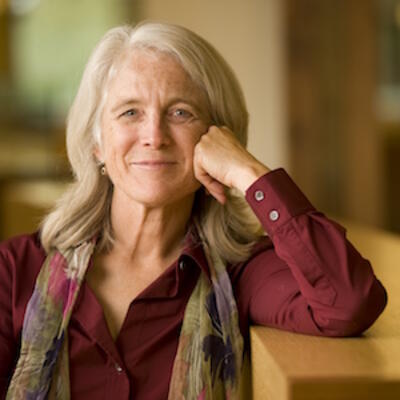
Ashley Boren

Max Gomberg
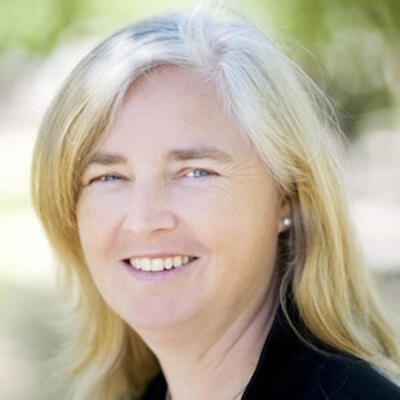
Gabriele Ludwig

Barton Thompson
Summary
Many Californians are wondering if El Niño has saved the Golden State from its historic drought. The snowpack in Sierra Nevada is more robust, reservoirs in Northern California are more full, and Folsom Lake even rose 10 feet in the month of March. However, the state is nowhere near pre-drought conditions. Three experts joined Greg Dalton at the Commonwealth Club to discuss the future of water in the Golden State.
Ashley Boren, Executive Director, Sustainable Conservation
Max Gomberg, Climate Change Manager, State Water Resources Control Board
Gabriele Ludwig, Director, Sustainability & Environmental Affairs, Almond Board of California
Barton Thompson, Director, Woods Institute for the Environment, Stanford University
This program was recorded in front of a live audience at the Commonwealth Club of California on April 5, 2016
Full Transcript
Greg Dalton: I’m Greg Dalton and on the show today, we’ll find out if California's drought is over. The wet season is over and the Sierra Nevada have a lot more water up there stored as snow than they did this time last year. Reservoirs in Northern California are also looking a lot better. Folsom Lake rose a whopping 10 feet in the rainy month of March but the picture around the state is not so rosy. And over the next hour we’ll discuss what lies ahead for our gardens and showers of the Golden State. We’ll also look at water that Californians and most Americans eat every week. Water tucked into fruits, nuts, dairies and vegetables produced here in California. This program is generously underwritten by the S.D. Bechtel, Jr. Foundation. And joining our live audience at the Commonwealth Club today we have four water experts. Gabriele Ludwig is Director of Sustainability and Environmental Affairs at the Almond Board of California. Buzz Thompson is Director of the Woods Institute for the Environment at Stanford University. And Ashley Boren is Executive Director of Sustainable Conservation, an environmental group that works with farmers and other businesses. And Max Gomberg is the Climate and Conservation Manager at the State Water Resources Control Board. Please welcome them to Climate One.
[Applause]
Welcome to you all. Buzz Thompson, is the drought over? Paint the big picture for us statewide in California.
Barton Thompson: So the drought is clearly not over yet. We've had a reasonable year this year, but at best it's an average year for the state as a whole. Much better in Northern California than in Southern California, which has continued to experience a drought. And right before coming here today I looked at NOAA’s most recent predictions as to what is likely to happen over the course of the summer and the fall.
And the best projections are that we are moving into a neutral period, sort of in-between the El Niño and the La Niña effect and we will actually probably by the fall there's about 50% probability that we will see La Niña again. And so we are not even close to being out of the danger that we've seen over the past four years. And of course the other problem is, is that the drought that we've seen so far was not just an ordinary drought. It was one of the worst droughts that we have seen just in terms of the total deficit precipitation. It is the worst drought in a millennium and or in a century and if you include the heat that was involved then it could be the worst we've seen in millennium.
Greg Dalton: Ashley Boren, you work with lots of different agricultural interests. How is this registering with the Ag industry, are they issuing a sigh of relief after a wet year saying, okay we -- no?
Ashley Boren: No. Definitely not, you know, and again it also varies across the state. So in, you know, the northern part of the valley it's not nearly as severe as it is in the southern part of San Joaquin Valley where there is a lot of farmers still aren't getting allocations of water or it varies even within the San Joaquin Valley depending on where you are. In the coastal areas, again in the southern part of the state are having, you know, still having serious water shortages.
Greg Dalton: So it’s a very local issue. Let’s talk about almonds, Gabriele Ludwig, almonds often villainized, we did a post on Facebook little horns on almonds, got lots of traction on that one. I think you put some ads on the radio to counter that sort of stuff, you know. How are the almonds faring now at this point in the water season?
Gabriele Ludwig: Well I very much second what Ashley said that it really depends on where you are because it depends on your water rights, it depends on, you know, things like that so and where you are in the water distribution system. So some growers are getting a hundred percent of their allocation and other growers just heard three days ago they're getting 5% of their allocation which is not covering their needs. So -- and then also I think to coming back to your larger question, I very much agree we don't think that the drought is over whether it's, whether drought or regulatory caused reasons for drought just water supply is going to be changing for variety of reasons.
Greg Dalton: Hold on. Regulators can cause drought?
Gabriele Ludwig: From our perspective, yes.
Greg Dalton: So they’re not letting, turning the tap wide enough and they’re holding it back to what, protect fish?
Gabriele Ludwig: It can be for fish, it can be for temperature, it can be for salt. I mean there’s a whole variety of reasons for water not being available or currently there’s water that would, could be traditionally would have been pumped into storage for use during the summer and because of fish it can’t be pumped.
Greg Dalton: Max Gomberg, did you cause this crisis?
Gabriele Ludwig: I didn’t say cause the crisis. It’s a component to it.
Max Gomberg: No. But as Gabriele mentions, there are reasons why water isn’t being delivered but that’s California water; its complex. We have to protect our ecosystems. We have to protect our urban areas and make sure that we have supplies for cities and we have to make sure that we still have a thriving agricultural economy it's a very difficult balancing.
Greg Dalton: In fact California I think has in law that there have equal measure, equal rights for ecosystems and human uses. So Gabriele Ludwig, do you think that that’s reasonable and fair, do you think it’s tilted in favor of human, you know, tilted in one direction or the other?
Gabriele Ludwig: I don’t think it's that simple because we’re all dependent on all of it. We all need the water whether we eat the food, we all depend on the ecosystems. And so again I think that's that antagonism as it’s been built up is to me part of the problem because it’s been really hard to have good conversations about how do we go from where we are now to the future if we view it as here are the environment rights, here are the ag rights, here are the urban rights.
We’re all in this together and we are all codependent. So how do we move forward from where the conversations been to a more productive conversation, it’s not an either or.
Greg Dalton: Do you think that almonds have been unfairly villainized?
Gabriele Ludwig: Of course I do. But I would also say that it’s part of the larger conversation that many people do not understand where their food comes from, what it takes to grow food. That I don't care what you eat there is water, a lot of water in that food. Almonds took the hit because we’re now one of the largest crops in the country. When I was in grad school, it’s getting some time ago there was a drought at that time there's about a million acres of cotton, cotton was villainized. So it really comes back to, you know, who which crops are grown and if you actually look at the data, the absolute amount of water going to agriculture hasn't changed that much over the last 20 years. What’s changed is which crop and then there’s also such statistics as the productivity amount of crop we grow with that water has really increased. So on average there’s about a 43% increase in productivity for all of California agriculture over the last forty years, so that’s more crop per drop. In the almond industry we have a 33% increase just in the last 20 years and that's partly changes in irrigation, partly changes in production practices.
So again, everything's evolving. We took the brunt of it, but really it was again part of that larger conversation about how do we deal with a limited water supply with so many different needs. And so it's easier to vilify than to have the hard conversation about how do we move forward.
Greg Dalton: Buzz Thompson, I’d like to hear your response to that. That Ag has made efficiency improvements and that, yeah, your response.
Barton Thompson: Yeah, so several things. First of all I think it is a time honored tradition in the water field to vilify everybody else. So if you're in Northern California it’s always the fault of Southern Californians, they’re stealing our water. If you are an urban area generally, then it's frequently the fault of the farmers. If you are a farmer it’s the fault of those environmentalists who are taking all the water that should be going to water the farms.
You know, when the legislature last considered the Delta on a comprehensive basis, as you pointed out Greg they decided that we had coequal goals. That we really should not try to prioritize one goal over another and that actually as Gabriele has already mentioned, we really should be thinking about how can we meet all of the various needs in the state. One of the things that we have learned from this particular drought is actually the fish are not doing particularly well despite our efforts for them. And part of that is that we do short them whenever we can. And what happens is, is that we sort of pushed things so far that they end up being put on the endangered or threatened species list. At that point a variety of regulations are clicked into place, which makes our life harder for people like Gabriele who need to be growing the food. And so one of the things that I think we do need to do is to take a step back and think more comprehensively about how can we ensure that the environment is protected on a continual basis and that we are doing everything we can to avoid having species listed.
Greg Dalton: Ashley Boren, why does the environment matter, if we don’t eat fish, why do fish matter? What’s really being protected there, they’re just food supply if it’s, if I live in the city and I don’t go to the Sierras, why do I care if some stream is preserved?
Ashley Boren: People do eat fish so there’s certainly that aspect of it, but they’re also I think important indicator species for some of our rivers and streams and ecosystems and floodplains. And so if your fish aren’t doing well it's usually a sign that other parts of the ecosystem aren’t doing well also. And in addition, there's lots of species that are dependent on those fish. So if you take that fish out of the system you have a cascading effect on another species. So it's the fish are important in themselves and valuable species and of themselves and for, you know, all the recreation and food they provide. But it's also the interconnected web of species that are dependent on them as well.
Greg Dalton: Buzz Thompson, Senator Feinstein has a bill introduced some legislation in Congress to kind of get the federal government in here with some money maybe some cement. What’s she trying to do, what’s the vision there for what she wants to do to address the water stress and shortage in California?
Barton Thompson: So I think Senator Feinstein is really trying to do almost the impossible in the California water space. Which is to please as many people as possible and in the process try and get legislation to actually pass through Congress. So she is focused not only on trying to increase the amount of water which is available to farms and urban areas in the short run, but also to provide the resources that are necessary to expand the state’s ability to meet drought conditions in the long run. And it's going to be very difficult, in order to get any bill passed through Congress to address California's drought unless you address some of those short-term issues.
She's doing it in a more considerate fashion than the House of Representatives would. She’s not proposing just a wholesale exemption from the Endangered Species Act, but instead trying to push back against the Endangered Species Act, as far as you can while leaving it in place. But I still question whether or not it's going to leave the environment where the protections are necessary. And I still have to question as to whether or not it’s actually gonna pass the Senate.
Greg Dalton: Gabriele Ludwig, do you welcome federal involvement, more money with their legislation, the federal government to come in here and help out agriculture and they’re already a big part of the water delivery system in the state already. Do you welcome more federal involvement?
Gabriele Ludwig: I have to admit I don’t know enough about that to give you a really good answer. But fundamentally, I think as I was saying the more we can bring people to the table to have the hard conversations and someone like a Senator Feinstein is one of the few people who could actually potentially make that happen. I think it's gonna be beneficial. And as you know Ashley can talk about if you look at any of these issues you always are gonna hit regulatory stumbling blocks. And again that’s something where someone in Congress can help figure out how do we make progress in that area to find -- get to the better place. So I think there's potential, but I’m also being upfront, I’m not the expert on them.
Greg Dalton: Ashley Boren, should the Endangered Species Act be loosened to there’s partial response to the drought?
Ashley Boren: That’s a very tough question. I think the Endangered Species Act has played a really important role in helping us protect the environment for species. I think there is probably room to tweak it, and to improve it and to have it have an ecosystem focus and not just on single individual species, but the importance of the ecosystem as a whole and the services the many services that our ecosystems provide for us. So, definitely maybe some tweaks, but it's certainly a very important law that needs to stay.
Greg Dalton: Max Gomberg, what’s the State Water Board’s position on whether the Endangered Species Act is in the way or it should be protected entirely as it is?
Max Gomberg: The state’s position is you don't go undoing federal legislation that’s been around for decades and is important to preserving our environmental values. I mean part of the answer to the question about why are the fish important is because California's economy is heavily based on tourism, right, and our natural environment that we all enjoy. People who live here and people who come visit. And we lost 22 million trees over the past few years. We’re not gonna have the same natural environment unless we protect it as well as again balancing our urban needs and our agricultural needs.
Greg Dalton: Max Gomberg, a year ago Governor Brown stood in a brown field that usually was covered with snow, announced some historic water restrictions in California, 25% about a year ago. How do we do?
Max Gomberg: We did very well. We hit almost 24%, 23.9% to be exact, and that really shows tremendous, tremendous resilience by the people of California because you're talking about over 38 million people all doing their part whether it was taking a shorter shower, turning off the irrigation whether it was businesses making changes to make their water use more efficient from beer production to data centers in Silicon Valley. All of it really showed tremendous response to this drought and when you think about, you know, 25% was a really ambitious goal that the governor set. That's one out of every four drops of water that was being used no longer being used over a span of nine months. So Californians did a tremendous job.
Greg Dalton: And going forward is that gonna be enough, will those restrictions be loosened, will they continue?
Max Gomberg: They've already been loosened a bit. They were loosened a bit in February due to the good start to the winner. As Buzz said, we’re improved, we’re not out of the drought, but conditions have improved. So we’re looking at that, the board is likely to act in May to set new rules for the summer.
Greg Dalton: And do farmers get some credit for that achievement as well, you mentioned kind of showers, et cetera that most of the water use in the state is in Ag. Did farmers, you know, do they share in that success?
Max Gomberg: They do. It's more complicated than it is in the urban sector for agriculture because you’ve got surface water that's governed by a complex water rights system; then you’ve got groundwater. We did pass a landmark groundwater law back in 2014, which is really gonna help to manage the different basins, some of which have been severely overdrawn in this drought. So we're making progress. Some farmers have had to do more than others because of where they fit in the hierarchy.
Greg Dalton: Gabriele Ludwig, how was that 25%? Was that pain, what that impact on the farmers that you know whether almonds or otherwise?
Gabriele Ludwig: Well, as we just said, I mean for farmers it was completely different process. So a number of farmers had already a hundred percent cuts, at least on the surface water as Max just explained already two years running before the governor put in the 25% cuts for all humans. So again, as Max was saying a much more complex process. So you had some growers with zero water allocation, other growers still with their full allocations. Now the system allows water trading to a point if you can move the water, and where growers could they used groundwater, no doubt about it. So coming back to the groundwater supply got tapped very heavily because of the drought.
So you really saw a wide range of experiences so in terms of how much water got cut and where it was. The way I put it is growers muddled through so they, you know, they bought water they used groundwater, they didn't grow annual crops. They planted, you know, young trees don't need as many much water as older trees. So there’s a whole bunch of ways that they try to figure out how can I keep my business running with having less water.
Greg Dalton: If you’re just joining us, we’re talking about the state water situation at Climate One. I’m Greg Dalton. That was Gabriele Ludwig, with State Almond Board. Also with us today is Buzz Thompson, from the Woods Institute for the Environment at Stanford. Ashley Boren, from Sustainable Conservation and Max Gomberg, from the State Water Resources Control Board.
Buzz Thompson, we just heard about drilling into groundwater. People were drilling deeper and deeper and taking out water that had been put there for, you know, a thousand years ago. So tell us about the groundwater situation and how we’re kind of drawing from that savings account that water people always talk about.
Barton Thompson: Yeah. So actually California law has long provided that we’re supposed to manage our groundwater aquifers on a sustainable basis. But the problem is that the only entities that really could enforce that were the courts and so it never got enforced. And as a result, we’ve been over drafting some of our most important groundwater aquifers in the state now for years. And that's a real problem when we get to a drought because in the drought if you're cut off from your service water supplies then that groundwater is that savings account that you can draw from. In 2014, the state for the first time adopted a comprehensive Groundwater Management Act, which is now going to require all local jurisdictions to adopt sustainable groundwater management plans. I never thought I would actually see the day when California adopted a law like that. It's an exceptionally well drafted and good law but having said that, it still could allow us for years in fact, for decades to continue to draw down on our groundwater. And I think one of the steps we really need to take is to set some really ambitious interim goals to ensure that we protect that groundwater which is so essential.
Greg Dalton: Gabriele Ludwig.
Gabriele Ludwig: One thing I wanted to add to that conversation is based on the Central Valley my understanding is that recharge is possible. So we've already had this in the past where part of the reason for the California aqueduct system and bringing water to the west side was to deal with overdraft of groundwater. And so when that water supply became available to growers they start using that for irrigation and actually groundwater recovered. So we have examples showing that groundwater recovery is possible with management and available water. So I just want to say that that we have potential here and that this will tie into how the Sustainable Groundwater Management Act is implemented is trying to figure out routes to help not only protect the water that's there but to recharge the water that is there.
Greg Dalton: So take water from the Delta to recharge groundwater that's taken out in the central from the ground of the Central Valley?
Gabriele Ludwig: No. Take water from floods like when you have a lot of water and use that for groundwater recharge.
Greg Dalton: Buzz Thompson.
Barton Thompson: Yeah. So two or three things. The first is that I agree with Gabriele entirely to the degree that we can soften the reduction in groundwater which is going to take place under the 2014 act we should do so. At the same time, I guess I would take the story of the Central Valley project and draw a different moral from it, which is that we were over drafting our groundwater and so as a result we brought in a brand-new source of water, which was the Central Valley project and the response to that was to think now we have all this water from the Central Valley project, we actually can expand our agricultural operations and so then we end up in a situation where we’re using all the Central Valley project water depending on that and we’re now back to over drafting our groundwater again.
And we do have a tendency I think in California -- we have a tendency everywhere in the world -- to believe that the problem of water shortages is simply to pour more water on the problem and ultimately that's not sustainable. At some point we can't continue to do that. And so I think we also need to be thinking in the state about in a state which is inherently dry and where we know droughts are gonna get worse and worse in the future. What is the limit to our water use and at what point do we need to say we have to learn to live with the water which is sustainably drawn.
Greg Dalton: Max Gomberg, the entire water system in the West was set up during an unusually historically wet period. There's more water on paper than there is in reality, are we facing an inevitable sort of shrinkage or belt-tightening here?
Max Gomberg: We’re already seeing it. You know, this is one of those areas where we look at what's happening with climate change. Our temperatures are getting warmer; our snowpack is receding. The Colorado River is in long-term drought that's water for eight different states in the West and the water doesn't even get to Mexico. That’s a serious problem that's long-term and needs to be addressed in part as Buzz mentioned not just through finding more water from elsewhere, but really being more efficient and reducing some of our uses. That's true for the Sierra Nevada as well; we’re losing that snowpack. It's only gonna be snow at higher elevations as temperatures warm. We’re also as some of Buzz’s colleagues at Stanford just came out with a paper showing that the evidence is already in that we’re going to more extremes. When we do have warm and dry periods, they’re gonna be even more warm and dry than they were in the past. So we’re gonna have longer and more severe droughts.
These are really pressing challenges plus we have population growth to deal with. I want to make a point on the discussion about the groundwater law. I agree with Buzz, it’s a good law it could've been a better law. And the way it could've been better is it could've required action more quickly. In some cases it goes out till 2040 until some areas of the state are actually required to manage their groundwater in a more sustainable way. So we've got some tune-ups to do.
Greg Dalton: Ashley Boren, we’re talking about a new normal here. A lot of people, individuals certainly perhaps farmers as they farmed the land, perhaps for generations they want to be the way it has been, they think the water that they've always had that they’re continued to be entitled to. What we’re hearing from Max Gomberg and scientists is there's a new normal, that there's water volatility, water stress. Is that sinking in with farmers that you're working with?
Ashley Boren: I think it definitely is, again, it varies across the state, certainly in the San Joaquin Valley where I think we’re seeing the most severe groundwater over draft and where the shortages are the greatest. It's definitely got folks attention and I think one example would be this Groundwater Management Act that was referred to. When that went to vote in the legislature, not one San Joaquin Valley legislator voted for the Sustainable Groundwater Management Act, but everyone is now really rolling up their sleeves now that it has passed to try to figure out how to make it work. And, you know, it's true I think we would all love to see it go into effect more quickly myself included, but I think it's also a huge change to manage groundwater. They've got to form groundwater sustainability agencies that align with the groundwater basins. There's a lot of data information they need to get, it’s just a whole another way of --
Greg Dalton: And Paso Robles just said we’re not doing that thank you very much. And what’s the consequence?
Ashley Boren: Well, if they don’t come up with the groundwater sustainability agency and/or they don't develop the plan and/or they don't meet the objectives they set out to do the state board has the authority to step in. And that's in a sense the stick to encourage these areas to come up with it on their own because state does really vary greatly, so it makes a lot of sense for a common resource like this for the stakeholders to come together to feedback how is that management --
Greg Dalton: Max goes down there with a big wrench. Okay. But first I want to ask about, we’ll get to -- Gabriele, sure.
Gabriele Ludwig: So I think, to add to this whole conversation because I don't think it's just a question of finding new water in the way you're describing it. To me it's about diversifying the water supply. So, certainly for the Central Valley part of the issues that we’ve relied on surface water which meant relying on snowpack storage and the gradual runoff dams or groundwater we don't really have much in between. And so the way I view it, and I think certainly from the Almond board something that we've been looking at well we’ve stepped back and said okay how do we use we fund research we fund, you know, that's part of what we take grow our monies for is where do we go from here what are the issues.
And so what we’re looking at is can we improve the irrigation. Can, you know, just with what we currently know can we bring new technology to bear on the irrigation to make it even more efficient than it currently is. But the bigger picture is really how do we invest into, you know, recycling groundwater recharge, use of water and so we have examples where we can see right now, you know, efforts to take water from the cities that has not already been allocated and say can we use that tertiary clean water and get it to where can be used for irrigation. We have efforts we’re been working with sustainable conservation in UC Davis to see if groundwater recharge is an option. Can since most of the land is Ag land, can that Ag land be used? We know in certain situations; again for almonds we’re not sure if the trees are gonna be happy with it. I mean there's basic agronomy questions that need to be answered in addition to the water side of it.
Where are we on, you know, using solar for some kind of desalinization, for things like that. So can we, again it’s not one big project but can we find ways to diversify and figure out how to adapt to all these changes, whether it's -- there are regulatory changes I'm sorry, there are regulatory changes whether it’s SGMA or other things that are affecting the water supply. And there’s climate change one. So that's really the conversation we need to be having to me, you know, -- SGMA is Sustainable Groundwater Management Act to translate an acronym -- is how do we go from where we are to that next step. And I think yes, there’s gonna be limits, but I also think there's a lot of potential that we haven't tapped into.
Greg Dalton: Ashley Boren, tell us about Don Cameron who is a farmer that it has something that may be a solution for doing what we’re talking about.
Ashley Boren: Yeah, can I just say one quick thing to add on to Gabriele’s point is it’s about diversion but it’s also really thinking about the system in a much more integrated way. You know, we tend to think about surface water, we think about groundwater separate sources and they’re obviously very connected. How we operate our dams for both of those, there's a lot that could be gained from thinking through how to think about the system in a more integrated way including land-use and forest management and other things that could really help build more resiliency and stability in our water supply.
So Don Cameron is a wonderful story Don Cameron is very innovative farmer in Fresno County who is entirely reliant on groundwater. And he is in an area of very severe groundwater overdraft but he, you know, had regularly had there are flood events and he would, you know, trying to keep the water from his land and finally said, you know, why don’t I just let this water come on my land and, you know, and recharge the groundwater. So in 2011, which was our last high water year he let the Kings River flow over onto his pistachio and his grape acreage, about 3000 acres it was, you know, 18 inches high for weeks at a time.
So, you know, not just flood irrigating but kind of uberflood irrigating. And he was able to recharge a tremendous amount of groundwater and it had no impact on his crop yields. And so you should know though that this is quite unusual because all of his neighbors would look at him and just say this, you know, this guy is insane, you know, he's gonna kill his crops. And so we have Sustainable Conservation has been partnering with him and grower associations like the Almond Board that there's a lot of potential for that concept because there's a lot of land in the Central Valley that is permeable. You know, that you could recharge water in their crops that we think could potentially handle it so, it’s not gonna solve the problem, you know, we definitely need to reduce pumping to get our groundwater to sustainable levels, but it could be a really important piece of the puzzle. Some of our studies show that in some basins they could make up to one third of the average annual overdraft with existing infrastructure. So it's significant.
Greg Dalton: Ashley Boren is with Sustainable Conservation, an environmental group in San Francisco. We’re talking about the drought at Climate One.
We’re gonna go to our lightning round. This is where we ask each speaker to respond to a brief question, yes or no question. Ashley Boren, what crop is the biggest water hog in California?
Ashley Boren: I think it’s, on a pure volume basis, I think it’s alfalfa.
Greg Dalton: Buzz Thompson, in the last five years, Orange County has made more progress than San Francisco in using water more efficiently, yes or no?
Barton Thompson: It has done a much better job of being able to recycle all the water that it is utilizing and then putting it down into an aquifer where it can realize it, so I would say yes.
Gabriele Ludwig: We’re not very good at one-word.
Barton Thompson: San Francisco is doing well. It’s not doing as well as the Orange County.
Greg Dalton: Professors and politicians I tell you. Max Gomberg, if you are writing a movie about water shenanigans in California, would the villain come from the agriculture industry or the Metropolitan Water District of Southern California?
[Laughter]
Max Gomberg: There are many villains, but there are many more heroes in California who are working hard to do the right thing and conserve water and diversify supplies.
Greg Dalton: Alright, we’ll look for Chinatown II, okay. Gabriele Ludwig, citizens should be wary of municipal water systems being operated by for-profit companies, yes or no?
Gabriele Ludwig: My gut reaction is yes. That’s purely a gut reaction.
Greg Dalton: Good, we like guts. Max Gomberg, fracking for natural gas may have serious impacts on water quality and human health?
Max Gomberg: In some places, yes.
Greg Dalton: Buzz Thompson, greywater is hyped and may even be harmful to urban water systems?
Barton Thompson: No, I think that’s wrong. I think greywater can be very valuable although there are much more effective ways of saving water such as, you know, broader recycling.
Greg Dalton: I think David Sedlak, water expert at Cal would say too much greywater diversion takes water out of sewage systems. There needs to be a certain amount of water going through pipes and sewage systems, if we’re too successful, the sewer gets clogged, I guess that’s a high class problem.
Barton Thompson: I’m not worried we’re ever gonna get to that particular state.
Greg Dalton: Ashley Boren, senior water rights in California probably will be changed if the current drought continues.
Ashley Boren: I think that’s probably unlikely. I think that would require a lot of battles in the court but I think there are probably are ways to tweak the systems so that we can improve how water gets allocated.
Greg Dalton: Gabriele Ludwig, do you think that senior water rights will be changed in California if the drought continues as they were done in Australia?
Gabriele Ludwig: It will be discussed, yes.
Greg Dalton: Max Gomberg, San Diego made a smart move investing nearly $1 billion in a desalination plant.
Max Gomberg: I’m not sure about that. If you look at the Australian experience, they went through a drought that lasted over a decade. They invested in multiple desalination plants and many of those plants are not running now and those are big, multi million in some cases, billion-dollar investments.
Greg Dalton: And the water from that plant will be twice the cost of other water in the area. Last question, Buzz Thompson, in your lifetime you will drink recycled water as a part of your daily normal life.
Barton Thompson: Boy, that’s -- I thought you’re gonna ask me whether I’ve drunk recycled water and I’ve done that. But, well, yes, the answer is I’ve actually done it my entire life because actually all water is recycled to some degree. But that’s a very important point because when we, you know, our concern about drinking recycled water what we really should be realizing is that frequently the water that we get out of rivers and streams has actually been used more frequently and is dirtier than the water that has been formally recycled.
Gabriele Ludwig: There’s beer now being made out of recycled water.
Greg Dalton: That ends our lighting round. How do you think they did, I think they did pretty well. Let’s give them a thanks to that.
[Applause]
[CLIMATE ONE MINUTE]
Announcer: And now, here’s a climate one minute.
Last summer, following the hottest year on record, nearly forty percent of Californians surveyed named the drought as their biggest concern. Ellen Hanak of the Public Policy Institute of California says that level of awareness was previously unheard of. She sees it as a wake-up call, a chance for Californians to turn the tide. But to do that, she says, we’ve got to come together – not take sides.
Ellen Hanak: The dialogue of division doesn't really help us. What we need to do is figure out how do we have all of this, how do we figure out how to work together because people in California need it all. They need food. I think we need to look at food security as as important as climate change and population growth. Because I interrupted myself, I didn't get to food security. We should have folks in urban California really valuing what we have in California as this incredible bounty that we can produce for ourselves and for the world. It's a great resource and instead it gets dismissed. And figuring out how to shepherd that and help those farmers that are now farming by iPad, if they can afford it, and being very thoughtful about it and figuring out how to do win-wins with the ecosystem, and have everybody feel heard versus everybody going to their barricades is how we come together as Californians, which is something we can do. We are in this together, we voted for it together, and it was totally all of the above. Something to do all these things we need to do versus picking one and dismissing the rest. We won't conserve our way out of it, we won't store our way out of it -- we've got to do all of it.
Announcer: That’s Ellen Hanak, Senior Fellow and Center Director at the Public Policy Institute of California. She came to Climate One in June of 2015. Now, back to Greg Dalton and his guests at the Commonwealth Club.
[END CLIMATE ONE MINUTE]
Greg Dalton: We’re talking about the drought here at Climate One with Gabriele Ludwig from the Almond Board of California, Buzz Thompson from Stanford. Ashley Boren from Sustainable Conservation and Max Gomberg, from the State Water Resources Control Board.
Let’s talk about dams, they’re a big part of the issue. Gabriele Ludwig, do you think that we need more concrete, raise some dams, more storage to capture water for the times that it’s needed?
[00:42:03] Gabriele Ludwig: Short answer is yes, which I know is a loaded question. But again, I consider that as part of this whole conversation about how do we deal with the changing way of water supply. So if we’re getting more rainfall in the winter and less snowpack is increasing dams, especially ones that we have already part of the conversation we need to have. I don't think that's the only solution --
Greg Dalton: So raise Shasta Dam?
Gabriele Ludwig: Could be an option. So I think we need to keep an open mind that that is something we need to think about, especially given the changing landscape because of climate change. But I would not say that's the only solution.
Greg Dalton: Max Gomberg, more dams in California there’s a trend in some places to tear down dams in Washington and perhaps I don't know what the governor is gonna announce soon here with the Klamath, but more dams in California, Max Gomberg.
Max Gomberg: Those Klamath dams are coming down by the way. So that we see as a really positive step and they're not the only ones that have come down. We had one in Carmel Valley that just came down. We have over 1,400 major dams in California. We've dammed every river at least once except one, some multiple times. More dams overall is not the answer. We do need to be able to take, when we do have wet years and a lot of flow, we need to be able to store that water as much as possible and we do have distributed reservoirs around the state to do that. We also need to get more of it in the ground as Ashley was saying. I think that's really a key focus, but more dams is not going to solve our fundamental problems with water supply in the state.
Greg Dalton: Buzz Thompson, can we build our way out of this we heard this in the presidential debate I think Carly Fiorina mentioned this, more storage more dams is that, that seems logical.
Barton Thompson: Yeah. I mean storage is clearly part of the solution but more dams is not necessarily part of it. You know, as Max has already pointed out, even if you build all of this new surface reservoirs that we've been talking about it only adds a couple of percentage to the available water supply that we have right now.
It would be very costly and in the case some of the dams you have to worry about the environmental consequences. On the other hand, we can as Max and Ashley have already pointed out, we can store the water underground. We have this vast amount of natural reservoir, which is available to us. And in addition to that, we also have to use the dams that we already have more smartly than we are right now. At the moment, we are frequently having to release water from dams in order to be able to ensure that they have flood control space and given the additional climate and weather information that we have now we could tweak that system in order to do a much better job of actually saving water for use.
Greg Dalton: Ashley Boren. Storing water underground sounds logical just not very fun to ski on, you can’t see it, I mean.
Ashley Boren: You can’t sail your boat on it.
Greg Dalton: Yeah.
Ashley Boren: Yeah. But for cost-effectiveness, it’s hands down; it’s much more cost-effective to store water in the ground. Some of these states we’ve done on just using active farmland are really low cost. You can do them easily, you know, it’s gonna take years if we can’t find other rivers or dams to build up it’s gonna take years to get that permitted through the process, even if you could get it approved. And we really are in an urgent situation I mean, we need to be preparing for continuing drought and future drought and our groundwater has three times the storage capacity of all our above ground reservoirs combined. I mean, I kind of think of the aboveground reservoirs as they store about a year's worth of California's water of what we use, they’re sort of for the flexible 12 month to 18 month horizon, but it's really our groundwater reservoirs that are gonna get us through future droughts and are the most important storage that we have to invest in.
Greg Dalton: Gabriele Ludwig, we haven’t talk too much about prices. Water prices have been going up in San Francisco because we rebuilt the tunnels to protect them from an earthquake. Do you see water prices increasing in the future and what’s that gonna do to farmers?
Gabriele Ludwig: Well again, coming back to water for agriculture is very complex and there's a lot of depending on where you are, where the prices are. So it's not a one-size-fit-all. Fundamentally yes I think water prices are going to come up and that ties into the previous conversation that whether you're talking dams or in general, we still need to invest in infrastructure. So for groundwater recharge you need to invest in certain infrastructure just to make that possible; to manage these dams differently you need to invest. So those are costs that someone is gonna have to bear so just for that reason. The other thing I would like to see is just currently some of the groundwater pumping is simply because the way surface water supplies does not match our current high efficient irrigation system. So we need to invest in just simply the water distribution systems for irrigation to meet our current irrigation systems demand. So just to give examples of, to me cement isn't the only answer, but that investment in infrastructure, including potentially dams or at least some components of it, is part of the conversation.
The other impact I would like to say if water increases is I mean one thing California boasts about is we have somewhere between 350 to 450 different crops that are grown in the state. Because of the diversity of ecosystems we have diversity of climates and because of having a unique Mediterranean climate for much of the state. So one consequence of increased water costs is we’re gonna lose some of that diversity.
Greg Dalton: Max Gomberg, if someone wants to do a housing development in California. They have to prove that there is water available to do it. Should the same be true for a walnut grove or tree nut grove or for farmers whose hedge funds that are financing new almond plantations in California? Should they have to prove that there is water just like a housing developer has to prove it?
Max Gomberg: Well we do. We have a law called the Show Me the Water Law for new housing developments over a certain size; they have to establish that the water supply is there. I think with the implementation of the Groundwater Management Act, we will see areas where new wells will not be permitted unless there is sustainable management of that basin.
I want to talk about another aspect of pricing if I may which is sort of pricing and human rights. We passed a law four years ago, the Human Right to Water Law in California. We have over 1.5 million people in the state, the eighth largest economy in the world who don't have access to safe and affordable drinking water. We have a huge challenge there and part of it is that systems are run with contaminants.
There is not enough financing to operate the systems effectively. We have to come up with a way to pay for that. So the infrastructure we need is not just the infrastructure that Gabriele's talking about, but we need infrastructure for safe and affordable drinking water for some of our most vulnerable populations.
Greg Dalton: Gabriele Ludwig when you talk to your members about climate, do they resonate with climate or do they say well the weather has been changing my whole life, my dad did this, you know, is that a concept that resonates with them and the fact that things may be fundamentally changing in a way that their ancestors didn't experience?
Gabriele Ludwig: I would say that in general climate at least the way it’s generally talked about does not resonate with most of agriculture because you’re in a business where you’re depending on the weather. So for them variability each year is already different; that's part of the nature of their business. So, but I would say that certainly the lack of a snowpack last year was a wake-up call. I definitely would see there's more conversations about how do we deal with this change, or you know, a lot of tree crops need a certain amount of chilling hours, if they don't get it, you don't get that much yield. So there's a number of things that are happening where I do think there's some question starting to be raised. So the way I would put it is if you put it that starkly like pure climate change the way you probably hear typically talk about probably --
Greg Dalton: The way the people in the Bay Area talk about it, they talk a lot different, yeah.
Gabriele Ludwig: Yeah, exactly. And your mission with your show, okay. That probably doesn't resonate. But if you talk about, you know, increased changes, you know, the extremes in weather, that resonates with them, you know, that's something they can understand. So it really depends on how you talk about the climate.
Greg Dalton: Buzz Thompson, You have a Water in the West program at Stanford. I’d like to hear your thoughts on how, you know, the broader sweep about how we’re entering a new normal, and how we kind of this been lulled into this place of this wetness that we've had for the last hundred years or so and how it's hard for the human mind to catch up with the new the new normal.
Barton Thompson: Yeah. So I mean, we clearly are moving into a totally new situation where the type of weather patterns that we have historically seen are not going to be the norm in the future. And we’re gonna have to be able to deal with that. We've been talking about various ways in which we can do it largely, for example through diversifying all the various methods that we have for obtaining water. I actually think that the public is getting the concept of climate change, and largely because of what's happening in the water field. It is an impact of climate change that we are seeing today. And one of the great things about working in the water field is when you go to water conferences everyone around you wants to talk about climate change. And that's been true for a decade now. I actually think this is one of the sectors that’s actually taking this problem seriously.
Greg Dalton: We’re talking about the drought at Climate One. I'm Greg Dalton and my guests are Ashley Boren with Sustainable Conservation, Buzz Thompson from Stanford, Gabriele Ludwig from the State Almond Board and Max Gomberg from the State Water Resources Control Board.
Let's go to our audience questions welcome to Climate One.
Male Participant: Gavin Newsom is elected governor, calls you up Ashley, Gabriele, Buzz, Max, separately calls you into his inner sanctum. I want to do for California water what I did for gay rights. I wanna do the right thing I don't care if somebody’s ox gets gored. What do you tell him?
Greg Dalton: Max Gomberg, Governor Newsom in 2018?
Max Gomberg: I’ve got a laundry list. But I think we really need to start with some serious equity issues that I alluded to earlier. We cannot call ourselves, you know, a leading state with Silicon Valley on the leading edge of things and have communities across the state where when there's a drought the well goes dry, there’s contaminated water. It's not acceptable. We need to fix that, we need the legislature to step up and pass a funding mechanism with gubernatorial support that will provide the type of funding that's needed to transform those systems into ones that provide safe and affordable drinking water so that all Californians can have it.
Greg Dalton: Ashley Boren, Governor Newsom on the phone?
Ashley Boren: Let me just add on to that then I’ll put one but one of that is reforming Prop 218 and Prop 26 so that we can actually figure out how to finance the infrastructure that’s needed for water. Which is one of the things the legislature and Governor Newsom could help get done.
The second I would say is really figuring out and investing in data and information. There’s a lot we just don’t know about our water use where the sources, the levels of groundwater, how groundwater is flowing, weather, all sorts of things and trying to figure out how to have a more transparent in data and information that we can all be operating off of that same set of information would be enormously helpful and a big move in the right direction.
Greg Dalton: Most people have no idea how much water they use or where it goes or know, you can have information on your phone these days, you can look into your house or see your electrical usage, you can’t do that for water.
Buzz Thompson, Governor Newsom on the phone.
Barton Thompson: It all comes back to prices. The price at which we charge people for water, we are basically starving the water sector of any type of innovation. So what I would urge is that we have a public goods charge on water. The public goods charge should deal with the equity issue that Max talked about. It should deal with the data issue that Ashley identified. It also should help to promote new technologies in the water field.
I did a study two years ago where we looked at the amount of innovation taking place in the water sector versus the energy sector. And what we found was water has always seen less innovation, but starting in about 2008 the amount of innovation and energy shot through the roof. The amount of innovation in the water sector remained largely flatlined. There are whole variety of reasons for that but one of them is there is just very little money available in the water sector to drive the type of innovation that’s needed.
Greg Dalton: And the water is also very locally regulated. Gabriele Ludwig.
Gabriele Ludwig: I just want to add that public sector, public goods charge is a wonderful idea and it should also be providing water for the environment so that we get more secure water for the environment.
Greg Dalton: Let’s go to our next audience question. Welcome to Climate One.
Male Participant: A question about the cycle of frequency of drought, I recall that mid-70s to later part of the 70s, we had severe drought. And I was a graduate student at Stanford. Joe Franzini, the great hydrologist actually was telling me or telling us that we have flood frequency, ten years flood, 25 years, 50 years, 100 years. Why can’t we just develop a frequency for drought so that the decision can be made because when you want to make, when you want to design a dam you have to have frequency analysis, you know, 100 years flood. If you don’t have 100 years flood, you can’t actually design your dam. So therefore, if you have frequency drought, then we can decide what to do.
Greg Dalton: I think the problem is that those old models were -- hundred year floods are now coming every 10 years, Buzz Thompson.
Barton Thompson: On your particular question, the problem is as Greg just mentioned the frequency of drought appears to be increasing. Max mentioned earlier that there is a new study that was just released at Stanford two days ago by Professor Noah Diffenbaugh and a number of his colleagues. And what that study looked at was what has been the weather conditions in California over the last 70 years, and to what degree have we seen the type of situation that has led to our current drought, which is a ridiculously resilient ridge of high pressure sitting off of the West Coast of the United States, preventing those storms from coming into California.
And what they found was that if you look over the last 70 years, that type of a problem has been much more common in the last 35 years than it was with the 35 years prior to that. Also interesting enough because you mentioned flood, it doesn't appear as if the frequency of floods has gone down. So what appears to be happening is that we’re going to the extremes. We’re gonna have more droughts and we’re going to have at least as many floods before and what is disappearing is what we might at one point have considered normal.
Greg Dalton: Last question. Let’s go to -- yes, sir.
Male Participant: Did the agricultural production in the San Joaquin Valley, did it suffer because of the drought?
Gabriele Ludwig: Some crops yes, some crops no. Generally, yes there have been production losses. Though, in terms of economies many times the prices were higher so the grower got a total higher total return but often with higher cost. So it's actually more complicated picture than to simply yes or no. But you had for example, 25% less acres of rice planted, just flat-out not planted a lot less --
Male Participant: I’m addressing the overall industry. As I read, I think I read that production was up.
Gabriele Ludwig: No, production was not necessarily up. The value was up but not necessarily the production.
Greg Dalton: Ashley Boren.
Ashley Boren: I was just gonna add, the value of production was up but a half-million acres I think was fallowed so that was not produced at all. And the reason that they were able to keep that value and continue to produce what they did is that they relied heavily on groundwater which comes back to why groundwater is such an important resource. It was a way that that economy didn't get disrupted as much as it might have because they were able to draw on the groundwater.
But if we keep taking water out and not replenishing it we’re not gonna be able to do that in the future. It's really crucial that we monitor our groundwater storage.
Male Participant: My experience is I was born and raised in Fresno. And one of the reasons I left Fresno was because of the chronically whiny farmers. And if you give farmers more water they just plant more crops. So somebody has to break down that egocentric mentality and --
Ashley Boren: Can I make an argument back?
Male Participant: Okay.
Ashley Boren: Do you eat? All of us are dependent on those farmers. All of us are free to not be farming because we have less than 2% of the population farming. So if you eat, and I don't care what you eat, you’re dependent on a farmer.
Male Participant: My comment to that is almonds and pistachios are not -- and grapes are not requisite in the average diet.
Ashley Boren: Mediterranean diet is the only diet that has been proven to be healthful. What's in that diet is fresh fruit, vegetables, nuts, olive oil, things we grow here very well.
Greg Dalton: And I have almonds in my drawer I just want you all to know. Right upstairs above this stage. Let's go quickly; we’ve got to wrap this up. Two questions, one each of you, Max Gomberg water smart food what should we people eat in California?
Max Gomberg: Well, the less meat people eat in general the smaller the water footprint. So it doesn't mean that people should stop eating meat, but if you want to lower your water footprint, more vegetables.
Greg Dalton: Ashley Boren.
Ashley Boren: Agreed.
Greg Dalton: Throw dairy in there. Buzz Thompson.
Barton Thompson: Agreed entirely. And then if we import all of our food from other countries, we’re just using up their water, not ours.
Greg Dalton: Gabriele Ludwig, it’s too easy to say eat almonds instead of hamburger to get your protein. But what do you think Californians should eat and to be water smart? Not almond burgers instead of -- almond burgers instead of --
Gabriele Ludwig: I mean, the data does say that meat products are high in water use and dairy products are high in water use.
But again, I come back to if you look at it a diverse diet, a healthful diet and in moderation. I mean the bigger issue is we all eat too much, so.
Greg Dalton: Yeah, 800 gallons of water something like that on a hamburger. Last question for each of you. What's the number one personal action that you did to reduce your water consumption during the drought. This time, starting with Gabriele Ludwig.
Gabriele Ludwig: I flush the toilet a lot less.
Greg Dalton: Buzz Thompson.
Barton Thompson: I put on a smart irrigation controller in my house which has reduced my irrigation consumption by about 80%.
Greg Dalton: You got a lawn at Stanford, okay. Ashley Boren.
Ashley Boren: I live in San Francisco and my postage stamp yard was already on drip but I reduced the water going through it down and that saved about I think about a third of the water my little house was using in San Francisco.
Greg Dalton: We killed the little postage stamp lawn at my house. It’s been ugly brown dirt for three years. Max Gomberg.
Max Gomberg: We stopped watering outdoors altogether and unfortunately that meant that the weeds survived.
Greg Dalton: And that's a big one we should've touch on more, perhaps on outdoor landscaping. We have to wrap it up there. Our thanks to Max Gomberg from the State Water Board, Ashley Boren from Sustainable Conservation, Buzz Thompson from Stanford University and Gabriele Ludwig from the State Almond Board. I'm Greg Dalton.
Our thanks to our funders for this program. This program was underwritten by the S. D. Bechtel Jr. Foundation. I’d like to thank our audience here in the room at the Commonwealth Club and online for joining us. Thank you all for coming.
